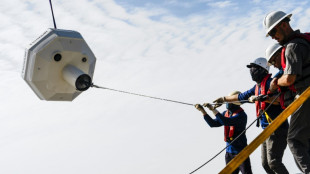
-
 Impressive Herbert leads Chargers into playoffs, Broncos denied
Impressive Herbert leads Chargers into playoffs, Broncos denied
-
One dead in Ecuador, Peru ports closed amid massive waves

-
 NBA hand out suspensions after fracas in Phoenix
NBA hand out suspensions after fracas in Phoenix
-
Atalanta snatch late draw at Lazio to hold Serie A lead

-
 Trump sides with Musk in right-wing row over worker visas
Trump sides with Musk in right-wing row over worker visas
-
Suriname rules out state funeral for ex-dictator Bouterse

-
 Alisson tells title-chasing Liverpool to create own history
Alisson tells title-chasing Liverpool to create own history
-
Israel army says ends raid against 'Hamas centre' in north Gaza hospital

-
 French skier Sarrazin 'stable' after surgery for crash injuries: federation
French skier Sarrazin 'stable' after surgery for crash injuries: federation
-
Israeli military confirms north Gaza hospital chief held in raid

-
 Abbas, Shahzad rock South Africa at start of chase
Abbas, Shahzad rock South Africa at start of chase
-
US deported record 61,680 Guatemalans in 2024: agency

-
 Double centurion Shah inspires Afghanistan fightback in Zimbabwe
Double centurion Shah inspires Afghanistan fightback in Zimbabwe
-
Diallo wants to make 'history' with struggling Man Utd

-
 Putin apologises to Azerbaijan without claiming responsibility in plane crash
Putin apologises to Azerbaijan without claiming responsibility in plane crash
-
Guardiola won't quit troubled Man City

-
 Gaza child amputees get new limbs but can't shake war trauma
Gaza child amputees get new limbs but can't shake war trauma
-
Evergreen Brignone powers to Semmering giant slalom win

-
 Thousands in Georgia human chain as pro-EU protests enter 2nd month
Thousands in Georgia human chain as pro-EU protests enter 2nd month
-
Turkey's pro-Kurd party meets jailed PKK leader

-
 WHO chief says narrowly escaped death in Israeli strikes on Yemen airport
WHO chief says narrowly escaped death in Israeli strikes on Yemen airport
-
Swiss Monney takes maiden World Cup win in Bormio downhill

-
 De Minaur wins but Australia crash to Argentina at United Cup
De Minaur wins but Australia crash to Argentina at United Cup
-
EU universal charger rules come into force

-
 Evenepoel targets return in time for Ardennes classics
Evenepoel targets return in time for Ardennes classics
-
Duffy bowls New Zealand to T20 victory over Sri Lanka

-
 Turkey's pro-Kurd party to meet jailed PKK leader on Saturday
Turkey's pro-Kurd party to meet jailed PKK leader on Saturday
-
Gaza hospital shut after Israeli raid, director held: health officials

-
 Surgery for French skier Sarrazin 'went well': federation
Surgery for French skier Sarrazin 'went well': federation
-
Mitchell, Bracewell boost New Zealand in Sri Lanka T20

-
 Kyrgios says tennis integrity 'awful' after doping scandals
Kyrgios says tennis integrity 'awful' after doping scandals
-
S. Korean prosecutors say Yoon authorised 'shooting' during martial law bid

-
 Vendee Globe skipper Pip Hare limps into Melbourne after dismasting
Vendee Globe skipper Pip Hare limps into Melbourne after dismasting
-
Reddy's defiant maiden ton claws India back into 4th Australia Test

-
 Doubles partner Thompson calls Purcell doping case 'a joke'
Doubles partner Thompson calls Purcell doping case 'a joke'
-
Reddy reaches fighting maiden century for India against Australia

-
 Sabalenka enjoying 'chilled' rivalry with Swiatek
Sabalenka enjoying 'chilled' rivalry with Swiatek
-
Political turmoil shakes South Korea's economy

-
 New mum Bencic wins first tour-level match since 2023 US Open
New mum Bencic wins first tour-level match since 2023 US Open
-
'Romeo and Juliet' star Olivia Hussey dies aged 73

-
 Brown dominates as NBA champion Celtics snap skid
Brown dominates as NBA champion Celtics snap skid
-
Indian state funeral for former PM Manmohan Singh

-
 France asks Indonesia to transfer national on death row
France asks Indonesia to transfer national on death row
-
Ambitious Ruud targets return to top five in 2025

-
 Late bloomer Paolini looking to build on 'amazing' 2024
Late bloomer Paolini looking to build on 'amazing' 2024
-
Australia remove Pant, Jadeja as India reach 244-7 at lunch

-
 Scheffler sidelined by Christmas cooking injury
Scheffler sidelined by Christmas cooking injury
-
Rice seeks trophies as Arsenal chase down 'full throttle' Liverpool

-
 Trump asks US Supreme Court to pause law threatening TikTok ban
Trump asks US Supreme Court to pause law threatening TikTok ban
-
Arsenal edge past Ipswich to go second in Premier League

| NGG | 0.66% | 59.31 | $ | |
| RIO | -0.41% | 59.01 | $ | |
| CMSC | -0.85% | 23.46 | $ | |
| SCS | 0.58% | 11.97 | $ | |
| CMSD | -0.67% | 23.32 | $ | |
| RYCEF | 0.14% | 7.27 | $ | |
| BTI | -0.33% | 36.31 | $ | |
| RBGPF | 100% | 59.84 | $ | |
| BCE | -0.93% | 22.66 | $ | |
| VOD | 0.12% | 8.43 | $ | |
| GSK | -0.12% | 34.08 | $ | |
| BP | 0.38% | 28.96 | $ | |
| RELX | -0.61% | 45.58 | $ | |
| AZN | -0.39% | 66.26 | $ | |
| BCC | -1.91% | 120.63 | $ | |
| JRI | -0.41% | 12.15 | $ |

Antarctic sea ice hits lowest winter maximum on record: US data
The sea ice around Antarctica likely had a record low surface area when it was at its maximum size this winter, a preliminary US analysis of satellite data showed Monday.
As the southern hemisphere transitions into spring, the US National Snow and Ice Data Center (NSIDC) said in a statement that Antarctic sea ice had only reached a maximum size of 16.96 million square kilometers (6.55 million square miles) this year, on September 10.
The ice pack typically reaches its largest size during the colder winter months, so the September 10 reading will likely remain this year's maximum.
"This is the lowest sea ice maximum in the 1979 to 2023 sea ice record by a wide margin," said the NSIDC, a government-supported program at the University of Colorado at Boulder.
At its high-point this year, the sea ice was 1.03 million square kilometers smaller than the previous record, roughly the size of Texas and California combined.
"It's a record-smashing sea ice low in the Antarctic," said NSIDC scientist Walt Meier.
He added that the growth in sea ice appeared "low around nearly the whole continent as opposed to any one region."
In February, at the height of the austral summer, the Antarctic sea ice pack had reached a minimum extent of 1.79 million square kilometers, also a record, according to the NSIDC.
The ice pack then grew back at an unusually slow pace, despite the onset of winter.
Meanwhile at the other end of the globe, where summer is drawing to a close, Arctic sea ice reached a low of 4.23 million square kilometers, the NSIDC said. It represents the sixth lowest minimum in 45 years of recordkeeping.
- Warming oceans -
For several decades, the Antarctic sea ice pack had remained stable, even expanding slightly.
But "since August 2016, the Antarctic sea ice extent trend took a sharp downturn across nearly all months" the NSIDC said.
There is debate among scientists over the cause of the shift, with some reluctant to establish a formal link with global warming. Climate models have struggled in the past to predict changes in the Antarctic ice pack.
The downward trend is "now thought to be linked to warming in the uppermost ocean layer," the NSIDC said.
"There is some concern that this may be the beginning of a long-term trend of decline for Antarctic sea ice, since oceans are warming globally."
Melting pack ice has no immediate impact on sea levels, as it forms by freezing salt water already in the ocean.
But the white ice reflects more of the Sun's rays than darker ocean water, so its loss accentuates global warming.
The loss of pack ice also exposes Antarctica's coastline to greater wave action, which could destabilize the freshwater ice cap and endanger coastal habitats. The melting land ice would cause a catastrophic rise in sea levels.
However the NSIDC notes a possibility that waves impacting the ice sheet may increase "accumulation near the coast, offsetting in part the threat of rising sea level."
S.Pimentel--PC




